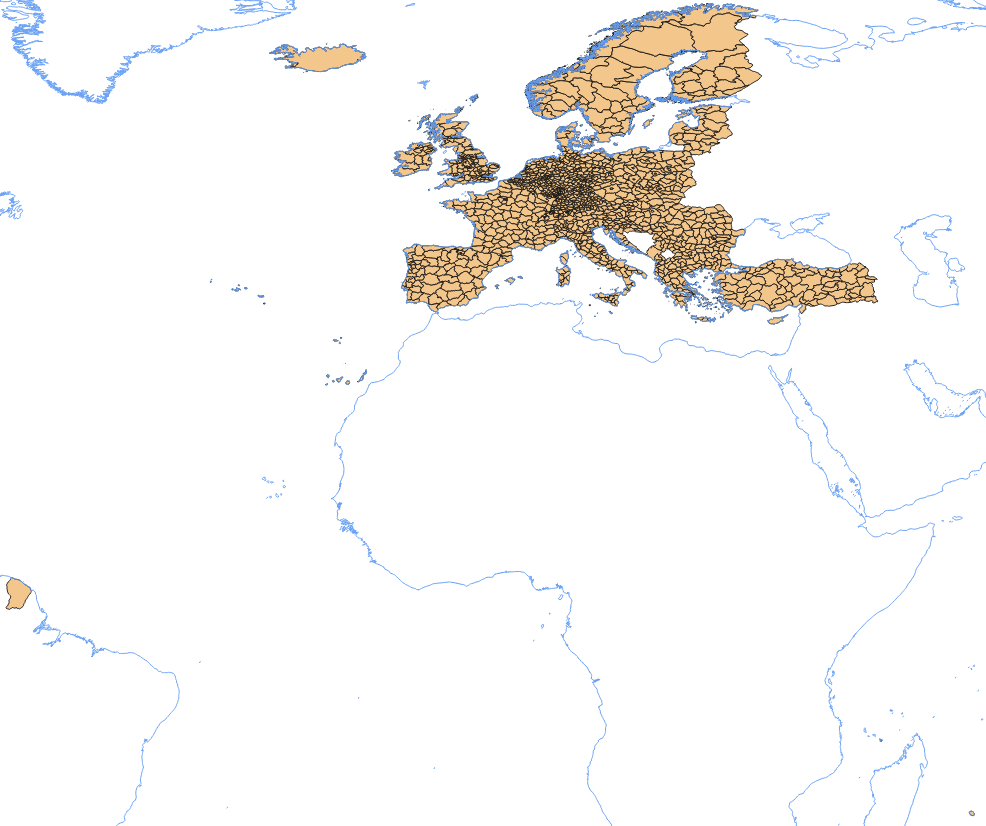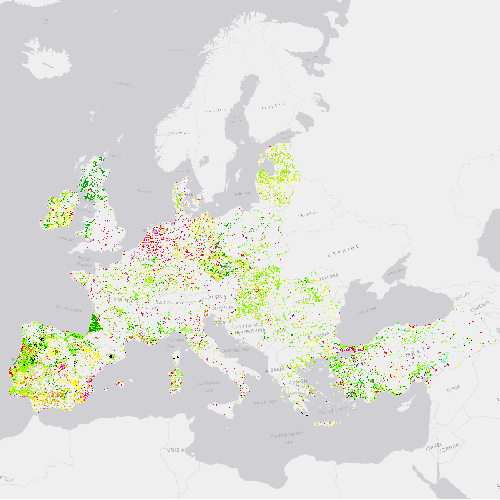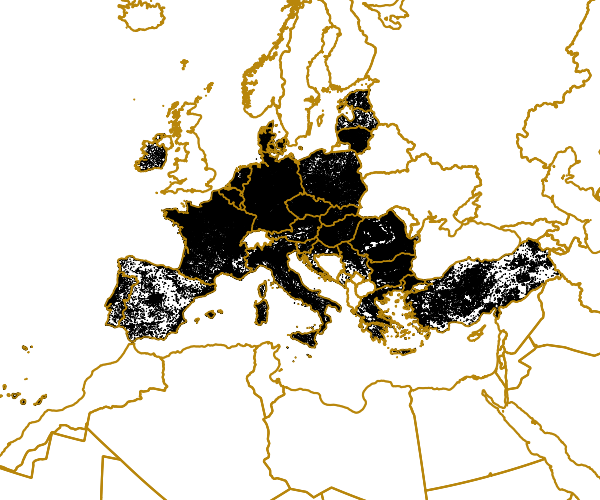Turkey
Type of resources
Available actions
Topics
INSPIRE themes
Keywords
Contact for the resource
Provided by
Years
Formats
Representation types
Update frequencies
status
Scale
Resolution
-

The grid is based on proposal at the 1st European Workshop on Reference Grids in 2003 and later INSPIRE geographical grid systems. The sample grid available here is part of a set of three polygon grids in 1, 10 and 100 kilometres. The grids cover at least country borders and, where applicable, marine Exclusive Economic Zones v7.0, http://www.marineregions.org. Note that the extent of the grid into the marine area does not reflect the extent of the territorial waters.
-

The grid is based on proposal at the 1st European Workshop on Reference Grids in 2003 and later INSPIRE geographical grid systems. The sample grid available here is part of a set of three polygon grids in 1, 10 and 100 kilometres. The grids cover at least country borders and, where applicable, marine Exclusive Economic Zones v7.0, http://www.marineregions.org. Note that the extent of the grid into the marine area does not reflect the extent of the territorial waters.
-

This dataset represents the regions for levels 1, 2 and 3 of the Nomenclature of Territorial Units for Statistics (NUTS) for 2016. The NUTS nomenclature is a hierarchical classification of statistical regions and subdivides the EU economic territory into regions of four different levels (NUTS , 1, 2 and 3, moving respectively from larger to smaller territorial units). NUTS 1 is the most aggregated level. An additional Country level (NUTS 0) is also available for countries where the the nation at statistical level does not coincide with the administrative boundaries. For example Mt Athos in Greece and Mellum and Minsener Ogg in Germany. The NUTS classification has been officially established through Regulation (EC) No 2016/2066 of the European Parliament and of the Council and its amendments. A non-official NUTS-like classification has been defined for the EFTA countries and candidate countries. An introduction to the NUTS classification is available here: http://ec.europa.eu/eurostat/web/nuts/overview. This dataset has been created mainly from the EuroBoundary Map v 12 (Eurogeographics) and geographic information from TurkStat for Turkey. The public dataset is available at 1M, 3M, 10M, 20M, 60M, while the full dataset at 100K is restricted. Coverage is the economic territory of the EU, EFTA countries and candidate countries as in 2016. This metadata only refers to a pre-release version of the full nuts 2016 dataset at 100k (it does not contain Albanian boundaries) and shall only be used internally by the EEA following the conditions stated in the document "GISCO-LicenseconditionsforEGdatasets.pdf" provided with the dataset. This metadata has been slightly adapted from the original metadata file provided by Eurostat (European Commission) and is to be used only for internal EEA purposes. For reference, the original metadata file provided by ESTAT (NUTS_2016.xml) is also available for download together with the dataset. The public datasets, at smaller scales, are available on http://ec.europa.eu/eurostat/web/gisco/geodata/reference-data/administrative-units-statistical-units/nuts#nuts16.
-

This dataset represents the regions for levels 1, 2 and 3 of the Nomenclature of Territorial Units for Statistics (NUTS) for 2013. The NUTS nomenclature is a hierarchical classification of statistical regions and subdivides the EU economic territory into regions of three different levels (NUTS 1, 2 and 3, moving respectively from larger to smaller territorial units). NUTS 1 is the most aggregated level. The NUTS classification has been officially established through Regulation (EC) No 1059/2003 of the European Parliament and of the Council and its amendments. A non-official NUTS-like classification has been defined for the EFTA countries and candidate countries. An introduction to the NUTS classification is available here: http://ec.europa.eu/eurostat/web/nuts/overview. This dataset has been created mainly from the EuroBoundary Map v 8.x (Eurogeographics) and geographic information from TurkStat for Turkey. The public dataset is available at 1M, 3M, 10M, 20M, 60M, while the full dataset at 100K is restricted. Coverage is the economic territory of the EU, EFTA countries and candidate countries as in 2013. This metadata only refers to the full dataset at 100k and shall only be used internally by the EEA following the conditions stated in the document "GISCO-LicenseconditionsforEGdatasets.pdf" provided with the dataset. This metadata has been slightly adapted from the original metadata file provided by Eurostat (European Commission) and is to be used only for internal EEA purposes. For reference, the original metadata file provided by ESTAT (NUTS_2013.xml) is also available for download together with the dataset. The public datasets, at smaller scales, are available on http://ec.europa.eu/eurostat/web/gisco/geodata/reference-data/administrative-units-statistical-units/nuts#nuts13.
-

The natural assemblage species indicator dataset is a forest dataset that measures the congruency between the potential and current tree species distribution. The natural assemblage indicator is considered one of the key indicator for the identification of High Nature Value forest area in Europe. The reference year for this data set is 2006 and the spatial coverage is including the 28 EU Member States, Liechtenstein, Norway, Switzerland, and Turkey. The methodological approach is based on two data sources: (1) EUNIS woodland, forest and other wooded land habitats, predicted potential distribution of habitat suitability –EEA- as potential distribution; (2) Relative probability of presence of forest tree species (RPP) of European Atlas of Forest Tree Species –JRC- as current distribution The dataset values express, in the fuzzy values between 0 and 1, the percentage of tree species vegetation agreed with potentially dominant tree species by pixels. This measure is independent of the current forest coverage. The values close to 1 mean high percentage of native tree species (natural) whereas values close to 0 are an approximation of a low level of naturalness, being a high percentage of non-native species.
-

Corine Land Cover Change 1990-2000 (CHA9000) is one of the Corine Land Cover (CLC) datasets produced within the frame the Copernicus Land Monitoring Service referring to changes in land cover / land use status between the years 1990 and 2000. CHA is derived from satellite imagery by direct mapping of changes taken place between two consecutive inventories, based on image-to-image comparison. CLC service has a long-time heritage (formerly known as "CORINE Land Cover Programme"), coordinated by the European Environment Agency (EEA). It provides consistent and thematically detailed information on land cover and land cover changes across Europe. CLC datasets are based on the classification of satellite images produced by the national teams of the participating countries - the EEA members and cooperating countries (EEA39). National CLC inventories are then further integrated into a seamless land cover map of Europe. The resulting European database relies on standard methodology and nomenclature with following base parameters: 44 classes in the hierarchical 3-level CLC nomenclature; minimum mapping unit (MMU) for status layers is 25 hectares; minimum width of linear elements is 100 metres. Change layers have higher resolution, i.e. minimum mapping unit (MMU) is 5 hectares for Land Cover Changes (CHA), and the minimum width of linear elements is 100 metres. The CLC service delivers important data sets supporting the implementation of key priority areas of the Environment Action Programmes of the European Union as e.g. protecting ecosystems, halting the loss of biological diversity, tracking the impacts of climate change, monitoring urban land take, assessing developments in agriculture or dealing with water resources directives. CLC belongs to the Pan-European component of the Copernicus Land Monitoring Service (https://land.copernicus.eu/), part of the European Copernicus Programme coordinated by the European Environment Agency, providing environmental information from a combination of air- and space-based observation systems and in-situ monitoring. Additional information about CLC product description including mapping guides can be found at https://land.copernicus.eu/user-corner/technical-library/. CLC class descriptions can be found at https://land.copernicus.eu/user-corner/technical-library/corine-land-cover-nomenclature-guidelines/html/.
-

CORINE Land Cover (CLC) was specified to standardize data collection on land in Europe to support environmental policy development. The reference year of first CLC inventory was 1990 (CLC1990), and the first update created in 2000. Later the update cycle has become 6 years. The number of participating countries has increased over time − currently includes 33 European Environment Agency (EEA) member countries and six cooperating countries (EEA39) with a total area of over 5.8 Mkm2. Ortho-corrected high spatial resolution satellite images provide the geometrical and thematic basis for mapping. In-situ data (topographic maps, ortho-photos and ground survey data) are essential ancillary information. The project is coordinated by the EEA in the frame of the EU Copernicus programme and implemented by national teams under the management and quality control (QC) of the EEA. The basic technical parameters of CLC (i.e. 44 classes in nomenclature, 25 hectares minimum mapping unit (MMU) and 100 meters minimum mapping width) have not changed since the beginning, therefore the results of the different inventories are comparable. The layer of CORINE Land Cover Changes (CLCC) is produced since the second CLC inventory (CLC2000). CLCC is derived from satellite imagery by direct mapping of changes taken place between two consecutive inventories, based on image-to-image comparison. Change mapping applies a 5 ha MMU to pick up more details in CLCC layer than in CLC status layer. Integration of national CLC and CLCC data includes some harmonization along national borders. Two European validation studies have shown that the achieved thematic accuracy is above the specified minimum (85 %). Primary CLC and CLCC data are in vector format with polygon topology. Derived products in raster format are also available. The seamless European CLC and CLCC time series data (CLC1990, CLC2000, CLC2006, CLC2012 and related CLCC data) are distributed in the standard European Coordinate Reference System defined by the European Terrestrial Reference System 1989 (ETRS89) datum and Lambert Azimuthal Equal Area (LAEA) projection (EPSG: 3035). Results of the CLC inventories can be downloaded from Copernicus Land site free of charge for all users. CLC data can contribute to a wide range of studies with European coverage, e.g.: ecosystem mapping, modelling the impacts of climate change, landscape fragmentation by roads, abandonment of farm land and major structural changes in agriculture, urban sprawl, water management.
-

CORINE Land Cover (CLC) was specified to standardize data collection on land in Europe to support environmental policy development. The reference year of first CLC inventory was 1990 (CLC1990), and the first update created in 2000. Later the update cycle has become 6 years. The number of participating countries has increased over time − currently includes 33 European Environment Agency (EEA) member countries and six cooperating countries (EEA39) with a total area of over 5.8 Mkm2. Ortho-corrected high spatial resolution satellite images provide the geometrical and thematic basis for mapping. In-situ data (topographic maps, ortho-photos and ground survey data) are essential ancillary information. The project is coordinated by the EEA in the frame of the EU Copernicus programme and implemented by national teams under the management and quality control (QC) of the EEA. The basic technical parameters of CLC (i.e. 44 classes in nomenclature, 25 hectares minimum mapping unit (MMU) and 100 meters minimum mapping width) have not changed since the beginning, therefore the results of the different inventories are comparable. The layer of CORINE Land Cover Changes (CLCC) is produced since the second CLC inventory (CLC2000). CLCC is derived from satellite imagery by direct mapping of changes taken place between two consecutive inventories, based on image-to-image comparison. Change mapping applies a 5 ha MMU to pick up more details in CLCC layer than in CLC status layer. Integration of national CLC and CLCC data includes some harmonization along national borders. Two European validation studies have shown that the achieved thematic accuracy is above the specified minimum (85 %). Primary CLC and CLCC data are in vector format with polygon topology. Derived products in raster format are also available. The seamless European CLC and CLCC time series data (CLC1990, CLC2000, CLC2006, CLC2012 and related CLCC data) are distributed in the standard European Coordinate Reference System defined by the European Terrestrial Reference System 1989 (ETRS89) datum and Lambert Azimuthal Equal Area (LAEA) projection (EPSG: 3035). Results of the CLC inventories can be downloaded from Copernicus Land site free of charge for all users. CLC data can contribute to a wide range of studies with European coverage, e.g.: ecosystem mapping, modelling the impacts of climate change, landscape fragmentation by roads, abandonment of farm land and major structural changes in agriculture, urban sprawl, water management.
-

CORINE Land Cover (CLC) data are produced from 1986 for European countries. Altogether four mapping inventories were implemented in this period, producing four status layers (CLC1990, CLC2000, CLC2006, CLC2012) and three CLC-change (CLCC) layers for three periods (1990-2000, 2000-2006, 2006-2012). To eliminate several inconsistencies from the usage of 100m raster version of original CLC data in the accounting systems at EEA, like Land and Ecosystem Accounting (LEAC), which uses a 1km grid (CUBE) base for calculation, a harmonization method were elaborated for the CLC and CLCC data. The applied solution for the harmonization combines CLC status and change layers in the 100m raster form in order to create homogeneous quality time series of CLC / CLC-change layers for accounting purposes. The so called "CLC accounting layers" fulfilling the relation: CLC-change = Harmonized CLC_ new status – Harmonized CLC old status. The modification method maximizes compatibility of “backdated” CLC status layers with CLC2012 and each other. However this simple solution causes several issues to be solved: (1) Harmonized CLC layers loose statistical comparability with original CLC layers, because of increased geometry; smaller than 25ha MMU features will appear locally where changes appear. In case of some CLC classes this causes significant differences. (2) “Fake features” are appearing in the backdated CLC status layers due to inconsistencies between CLC-change datasets. CLC1990 was the first CORINE Land Cover inventory and lasted for 10 years. Photo-Interpretation mostly done on plastic overlay. Field checking was an integral part of the work. The basic parameters of the project (25 ha minimum mapping unit, 100 m minimum mapping width and the European level-3 nomenclature) tested. These are used consistently in all subsequent inventories.
-

An urban morphological zone (UMZ) is defined as a "set of urban areas laying less than 200 m apart". This layer contains UMZ delineations for Europe, based on Corine Land Cover database. During 2012, the UMZ methodology was updated in order to correct errors derived for the water course as join elements between urban areas. Previous version applied over CLC v15 (and previous version) joined many small urban areas due to the water presence. This fact was erroneous from the landscape and urban perspective as most of those areas remain as urban-rural typologies. Moreover, water courses cannot be considered as roads from the urban morphological view (either from the commuting point of understanding). This new version, known as v16, corrected this effect in the majority of cases.
 RUC Geo-Data catalogue
RUC Geo-Data catalogue